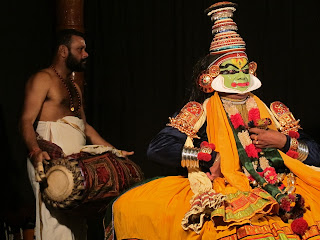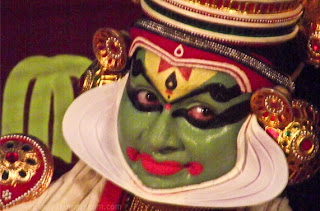Wednesday, March 13, 2013 | 4:28:00 AM
Kathakali belongs to south Indian state of Kerala where it originated in the 17th century. This dance form has its roots related to the Hindu mythology. It means a story play or a dance drama. The prominent features of this dance form is attractive make-up of characters, elaborate costumes, detailed gestures and well-defined body movements presented in tune with the anchor playback music. It is a popular belief that kathakali originated from "Krishnanattam".Now a days it has improved by the addition of new looks, refined gestures and added themes.
Kathakali is a classical art form which is characterise by the movements of the hands, facial expressions and bodily movements. The movements of the hands are called mudras. It is a sign language used to tell the story.
The dance performances are religious in nature. They are typically influenced by Mahabharata, the Ramayana and the ancient scriptures known as the Puranas. The dancers wear large head dresses, and the contours of the face are extended with moulded lime. The extraordinary costumes and make-up serve to raise the participants above the level of mere mortals, so that they may transport the audience to a world of wonders. The faces of noble male characters Rama, etc., are predominantly green. While the faces of the evil characters such as Ravan are painted green but they have slashed red markings. The language of the songs used for Kathakali is Manipravalam.
In olden times a dance performance used to continue for the whole night. At present it is reduced to two to three hours. The tradition which is followed from the past that Kathakali performance begins in the evening. A simple stage is used for the performance where large oil-fed lamp is placed in front of the stage. Two people hold the curtain. There are different dance styles which differ in hand gestures and stress on dance than drama and vice versa.
This dance is performed by men only. Female’s characters are also performed by them. However this dance has opened the doors for the women also. Now women are also started becoming Kathakali dancers. It takes eight to ten years of rigorous practice to transform into a Kathakali Dancer .
"The International Centre for Kathakali" at New Delhi has taken up a continuing project since 1980 to modernise, propagate, promote and popularizing Kathakali.
Vasu Pisharody: A Living Legend
He is a leading Kathakali artiste known for his character roles in the classical dance-drama of Kerala. After schooling he took Kathakali lessons under Balakrishnan Nair at Kerala. He undertook further studies for seven years. He is a winner of the prestigious Central Sangeet Natak Akademi award. He took a break from Kathakali since 2005 but latter in 2009 he made a comeback.
Posted By Desievite Admin







